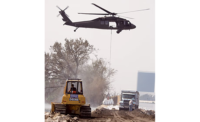...first responders, the National Guard or emergency management? “We have been talking to a lot of people and trying to get buy in,” Laska says. By next summer, DHS plans to conduct full-scale tests at an as-yet-undetermined location, Laska says. “There is a national need for us to research ways to handle not just terrorist threats, but those caused by natural disaster,” Laska says. The U.S. has almost 100,000 miles of levees, including 14,000 miles of federal levees and 85,000 miles of state, local or privately managed levees, he says. Aging, subsidence and insufficient maintenance funds already have contributed to failures in New Orleans, the Midwest and California.
Funding for the “Rapid Repair of Levee Breaches” study has grown since 2007, when ERDC began exploring rapid-repair methods after levees failed in New Orleans in the aftermath of 2005’s Hurricane Katrina. DHS is expected to support the research and construction of a full-scale test site in 2010, at a projected cost of $4.75 million. “The full-scale site will require some unique characteristics, including 15,000 cfs flow rate,” Laska says. DHS is looking at sites in California, Louisiana and Mississippi, as well as the Stillwater facility.
Baldwin is excited about the tubes. Since 1998, the San Joaquin County Office of Emergency Services has been developing flood-contingency maps and devising plans to use existing features, like railroad embankments, to contain flooding in the event of a levee failure. Until now, Baldwin had assumed the speedy construction of barriers or dumping of fill were the only options for containment.
Baldwin says he thinks ERDC’s research in rapid repair is a step in the right direction but that much more needs to be considered in tackling the 40-year-old “magic mentality” about levees. “Everyone is focused on putting money into primary levees, but we have got to get better at dealing with the issue of what happens when they break,” Baldwin says. “If we have learned anything from Katrina, we should [know] levees will breach. We can do this defensive method for much less money than building a new levee.”
Apart from the technology, the biggest challenge is to change perceptions about protection and risk and to resolve operational issues like cost, stockpiling and deployment, Baldwin says. He says the Corps and/or DHS must push for a national clearinghouse for the tubes to drive the cost down and increase accessibility.
So far, ERDC has proven the tube-sealing technology for 30-ft to 60-ft-wide breaches, but Resio says research needs to continue. “We do not know if we can go up to hundreds-of-foot breaches, but I think we can do it with multiple tubes,” Resio says. He also suggests there is other research under way for military purposes that might have flood-fighting applications. “We need to think across the lines sometimes,” Resio says.
Resio notes that breach-repair technology changed little between the disastrous 1927 flood in Louisiana and the levee failures in 2005. “In 1927, everyone waited until the flood finished and then went in and dealt with it,” he says. After Katrina, at the breach sites on the 17th Street Canal, the effort focused on limiting breach growth while 700-lb and 3,000-lb sandbags were dropped into the gap, yet the flooding continued for a week. “Had we been able to close the breach by 1 p.m. the day after, it would have saved $1.5 billion in direct cost and $15 billion in indirect cost,” Resio says.
“This is not just for New Orleans but for places where flooding will inevitably occur because, despite trillions of dollars of investment and all of our best intentions, we cannot fix it all,” Resio says. “What we are trying to do is create anything innovative to use for flood fighting.”


Post a comment to this article
Report Abusive Comment